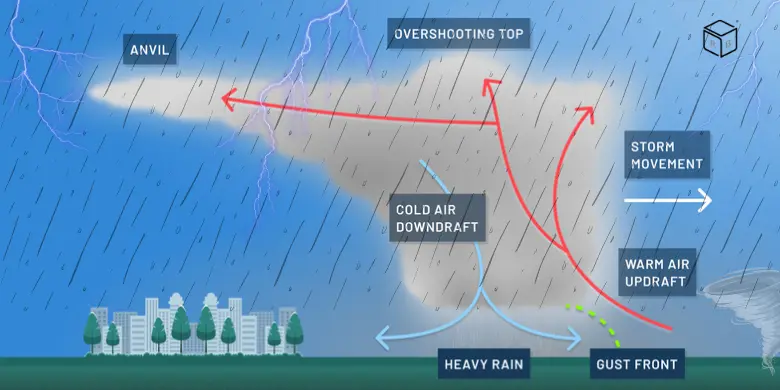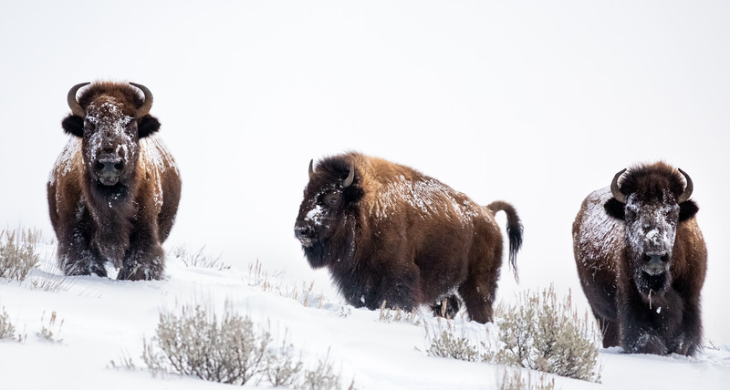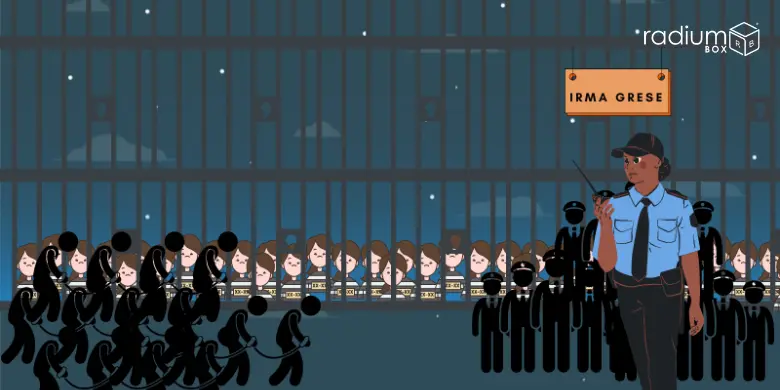Thunderstorms are common weather phenomena that occur all over the world. They are characterized by the presence of lightning, thunder & rain. However, not all thunderstorms are created equal. Some can be more severe than others, producing strong winds, hail & even tornadoes. One type of severe thunderstorm is the squall line.
Definition of Squall Line
A squall line is a type of thunderstorm that forms in a line, usually several hundred miles long. It is also called a quasi-linear convective system (QLCS). These thunderstorms typically form along a cold front or a dry line, which are boundaries between different air masses, which act as a trigger for their formation. They are most common in the spring & summer months in the central and eastern parts of the United States.They are known for their rapid movement and can travel at speeds of 40 to 60 miles per hour, making them a swift & formidable weather phenomenon.
Formation of Squall Line
Squall lines typically form in an environment with warm, moist air near the surface & cooler, drier air aloft. The pre-squall line environment is characterized by high instability, which means that there is a lot of energy available for thunderstorm development.
As the cold front approaches, it forces the warm, moist air to rise rapidly, creating a narrow band of strong updrafts. This updraft zone (advancing cold front or dry line) is called the leading edge, and it marks the beginning of the squall line. As the leading edge moves forward, it pushes the warm air up and over the cooler air aloft. This creates a sloping front that separates the warm, moist air from the cooler, drier air.
One of the key factors in the formation of squall lines is wind shear, which refers to the change in wind speed & direction with height. Wind shear can create horizontal rolling motions in the atmosphere, called as mesoscale convective vortices (MCVs), which can be trigger the formation of squall lines. These MCVs can initiate the upward motion of air, leading to the development of thunderstorms along the line.As the squall line continues to move forward, it produces a gust front or outflow boundary, which is a horizontal wind shift that marks the leading edge of the cold air behind the squall line.
Characteristics of Squall Line
As the squall line proceeds to move front, it produces a gust front or outflow boundary, which is a horizontal wind shift that marks the guiding border of the cold air behind the squall line.
The outflow boundary serves as a new source of lift after, it is created, resulting in the development of more thunderstorms along the squall line. The blow in front can be quite strong, with winds exceeding 50mph. When an unstable atmosphere combines with favorable wind shear, it can form accurate conditions for the formation of squall lines. These newly arisen storms can produce their own outflow boundaries, which can in turn produce new thunderstorms. This process can proceed for several hours, resulting in a long-lived and sometimes very intense squall line.
Squall lines can be very intense, producing a variety of weather conditions that can be hazardous to life and property. Here are some of the key characteristics of squall lines:
Wind Speed
Squall lines are often associated with strong winds, which can exceed 60 mph in few cases. These winds can cause damage to buildings, trees & power lines & can even overturn vehicles.
Rainfall
Squall lines are known for producing heavy rainfall, which can lead to flash flooding. The intense thunderstorms within the line can produce copious amounts of rain in a short period of time, causing rapid rises in rivers & streams.
Lightning
Squall lines often exhibit frequent lightning activity with lightning strikes occurring in rapid succession. This can pose a danger to outdoor activities & increase the risk of wildfires.
Tornadoes
Some squall lines produce tornadoes. Tornadoes that form within a squall line are frequent short-lived but can be very intense. They can cause significant damage especially if they occur in urban areas.
Duration
Squall lines can last for several hours, with new thunderstorms continuously developing along the line. The intensity of the storms can vary, with some being more severe than others.
Impacts of Squall Line
Squall lines can have a variety of impacts on the environment and people. Some of the most common impacts include:
- Property damage: Strong winds & heavy rain can damage buildings, trees & power lines, causing power outages and other disruptions.
- Transportation disruptions: Squall lines can cause hazardous driving conditions, especially if visibility is reduced due to heavy rain or if winds are strong enough to overturn vehicles.
- Flooding: Squall lines can produce heavy rainfall, which can cause flash flooding, particularly in urban areas where drainage systems may be overwhelmed.
- Crop damage: Severe weather associated with squall lines can damage crops & other vegetation, reducing yields and causing economic losses.
Safety Precautions
If you live in an area that is prone to squall lines, it is important to take safety precautions to protect yourself and your property. Here are some tips:
- Stay informed: Monitor local weather forecasts and be aware of the potential for severe weather. If a squall line is expected, stay tuned to local news and weather updates.
- Seek shelter: If you are outdoors when a squall line approaches, seek shelter immediately. Move to a sturdy building or a vehicle, and avoid seeking shelter under trees or other tall objects that could be struck by lightning.
- Stay away from windows: If you are indoors during a squall line, stay away from windows and doors. Flying debris can be hazardous, and strong winds can cause windows to break.
- Have an emergency kit: Make sure you have an emergency kit that includes essential supplies such as water, food, and first aid supplies. Be prepared for power outages and other disruptions that could last for several days.
Conclusion
Squall lines are a case of severe thunderstorm that can produce a variety of hazardous weather conditions. They form in a line & are often associated with a cold front. Squall lines can be very intense and long-lived, with new thunderstorms continuously developing along the line. It is important to take safety precautions if you live in an area that is prone to squall lines.

How common are squall lines?
- Squall lines are most common in the spring and summer months in the central and eastern parts of the United States, but they can occur in other parts of the world as well.
Can squall lines produce tornadoes?
- Yes, squall lines can produce tornadoes, although not all squall lines do.
What should I do if I am caught outside during a squall line?
- Seek shelter immediately. Move to a sturdy building or a vehicle, and avoid seeking shelter under trees or other tall objects that could be struck by lightning.
How long can a squall line last?
- Squall lines can last for several hours, with new thunderstorms continuously developing along the line.
What are some of the impacts of squall lines?
- Squall lines can cause property damage, transportation disruptions, flooding, and crop damage, among other impacts.




